AUCTORES
Globalize your Research
Chat with usResearch Article | DOI: https://doi.org/10.31579/2688-7517/212
1Head Medical affairs Indoco Remedies Mumbai.
2MD. Diabetologist, Akshay Hospital, Erandwane, Pune.
3Medical Advisor Indoco Remedies Mumbai.
*Corresponding Author: Abhijit Trailokya, Head Medical affairs Indoco Remedies Mumbai.
Citation: Abhijit Trailokya, Suhas Gopal Erande, Amar Shirsat, (2024), Real world evidence of Alogliptin on the continuous glucose monitoring in Indian type II diabetes mellitus patients in a retrospective, observational case-based studies, J. Pharmaceutics and Pharmacology Research, 7(10); DOI:10.31579/2688-7517/212
Copyright: © 2024, Abhijit Trailokya. This is an open access article distributed under the Creative Commons Attribution License, which permits unrestricted use, distribution, and reproduction in any medium, provided the original work is properly cited.
Received: 21 August 2024 | Accepted: 30 August 2024 | Published: 03 September 2024
Keywords: CGM; time in range; time above range; time below range; HbA1c; Alogliptin CGM; time in range; time above range; time below range; HbA1c; Alogliptin
Aim: To determine the safety and efficacy of Alogliptin on parameters of continuous glucose monitoring (CGM) in type 2 diabetes mellitus (T2DM) patients in a retrospective, observational, real-world settings.
Materials and Methods: Two patients (Case 1 and Case 2) with T2DM from a single center in India who received Alogliptin as a add on therapy to existing oral antidiabetic drugs (OADs) were retrospectively analyzed in the study. CGM was done approximately two weeks prior to the addition of Alogliptin and repeated again after three weeks of adding Alogliptin to the existing OADs for a period of 15 days. Average glucose level, percentage time in target range (70-180 mg/dl), percentage time above target and percentage time below target were determined before and after adding Alogliptin to the existing treatment regimen.
Results:
After addition of Alogliptin 25mg to existing anti-diabetic drugs, there was a reduction in the average blood glucose level from 196 mg/dl to 149 mg/dl in case 1 and from 158mg/dl to 125mg/dl in case 2 after approximately five weeks. Improvement was seen in the percentage time in target range (70-180mg/dl) from 45% to 75% in case 1 and from 67% to 91% in case 2 after approximately five weeks of adding Alogliptin to existing OADs. Percentage time above target decreased from 55% to 23% in case 1 and from 32% to 7% in case 2 after five weeks of adding Alogliptin to existing OADs. Also, there was a reduction in HbA1c from 8.8% to 8.3% in case 1 and from 8.4% to 7.2% in case 2 after a period of five weeks of Alogliptin addition to the existing antidiabetic regimen.
Conclusion: Alogliptin was found to be effective in reducing glycemic fluctuations in patients who were uncontrolled on other oral anti-diabetic medications. There were improvements in CGM parameters like increase in percentage (%) time in Target range (70-180 mg/dl) and decrease in percentage (%) time above target range after adding Alogliptin to the existing anti-diabetic medications.
Diabetes mellitus is a chronic condition causing metabolic derangement and is characterized by hyperglycemia which is persistent. Chronic hyperglycemia can lead to microvascular complications like retinopathy, nephropathy, and neuropathy and macrovascular complications which increases the risk of cardiovascular diseases by several folds.1 In the patients suffering from T2DM the primary predictor for the development and progression of microvascular complications remains the HbA1c levels. The recent evidences suggest an association in the diabetes related microvascular complications and the time in range (TIR).2 Recent clinical data indicate that glycemic variability (GV) is associated with increased risk of hypoglycemia, microvascular and macrovascular complications, and mortality in patients with diabetes, independent of glycated hemoglobin level. The use of continuous glucose monitoring device has markedly improved the assessment of GV in clinical practice and facilitated the assessment of GV as well as hypoglycemia and hyperglycemia events in patients with diabetes.3
Incretin-based therapies are one of the preferred oral antidiabetic agents in the management of type 2 diabetes due to lower incidence of hypoglycemia and weight-neutral or weight losing potential of these drugs. Alogliptin is a highly selective DPP-4i approved by USFDA/ EU (2013), DCGI (2014) to improve glycemic control along with diet and exercise in T2DM.4 Alogliptin has the time to maximum concentration (Tmax) of 1-2 hours with a half-life (t1/2)of ~ 21 hours and bioavailability of 100%. Alogliptin has a long intrinsic half-life (21 hours) and therefore it is eliminated slowly, and has a sustained DPP-4 inhibition (≥ 75$ hours post dose) facilitating convenient once daily dosage (OD)(25mg OD).5 Alogliptin is 100,000 fold more selective for DPP-4 than other related enzymes like DPP-8 and DPP-9.6 In Asian patients, Alogliptin reported a higher efficacy and good tolerability, as compared to Non-Asian patients with diabetes mellitus.7
The objective of this study was to determine safety and efficacy of Alogliptin through continuous glucose monitoring (CGM) in patients with T2DM in a retrospective observational case based studies.
The baseline characteristics of the two Indian patients with type 2 diabetes included in this study are summarized in Table 1. Data of the two patients who received Alogliptin as routine clinical practice in management of T2DM was analyzed retrospectively from the single center. Data was collected from the past medical records of these two patients. Free Style Librepro 1.0.6 was used for CGM. CGM was done approximately two weeks prior to addition of Alogliptin and repeated again after three weeks of adding Alogliptin to existing OADs for a period of 15 days. Average blood glucose level, Percentage time in target range (70-180mg/dl), Percentage time above target and Percentage time below target were determined prior to and after addition of Alogliptin to the existing antidiabetic treatment regimen.
| Demographic parameter | Case no 1 | Case no 2 |
| Age | 54 years | 32 years |
| Sex | Female | Male |
| Fasting blood glucose (mg/dl) | 162 | 111 |
| Post prandial blood glucose (mg/dl) | 189 | 148 |
| HbA1c % | 8.8 | 8.4 |
Table 1: Baseline Characteristic of the patients
Result:
In case 1, there was a reduction in the average blood glucose level from 196mg/dl to 149 mg/dl after five weeks of adding Alogliptin to the existing antidiabetic treatment regimen. (figure 1A). The percentage time in target range (70-180 mg/dl) increased from 45% to 75%, percentage time above target decreased from 55% to 23% (refer table 2, figure 2A, 2B, 3A and 3B) after adding Alogliptin 25mg to the existing antidiabetic treatment regimen. HbA1c was reduced from 8.8% to 8.3% (fig 6A) after five weeks of Alogliptin addition to the existing antidiabetic therapy. The percentage time below target was 0% and 2%, before and after addition of Alogliptin to existing therapy respectively (after five weeks). (refer table 2,3, figure 2A, 2B, 4A,4B.)
In case 2, there was a reduction in average blood glucose level from 158 mg/dl to 125mg/dl after five weeks of adding Alogliptin to existing OADs (figure 1B). The percentage time in target range (70-180 mg/dl) increased from 67% to 91%, percentage time above target decreased from 32% to 7% (refer table 3, figure 4A, 4B, 5A, 5B) after adding Alogliptin 25mg to the existing antidiabetic treatment regimen. HbA1c was reduced from 8.4% to 7.2% (refer figure 6B) in case 2 after five weeks of add on therapy of Alogliptin addition to the existing antidiabetic therapy. The percentage time below target was 1% and 2%, before and after addition of Alogliptin to existing therapy respectively (after five weeks). (Refer table 2,3, figure 2A, 2B, 4A,4B.) There were no episodes of hypoglycemia noted in both patients during this five weeks study period. This retrospective data demonstrated the efficacy of Alogliptin after addition to existing therapy in terms of improvement in glycemic variability.
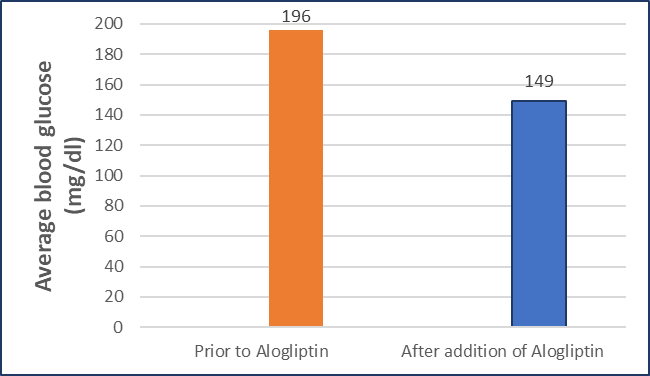
Figure 1 A: Average blood glucose prior to Alogliptin and after five weeks of addition of Alogliptin to the existing therapy in Case 1
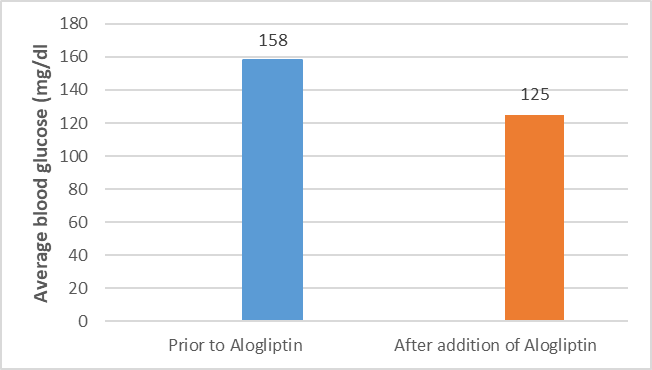
Figure 1 B: Average blood glucose prior to Alogliptin and after five weeks of addition of Alogliptin to the existing therapy in Case 2
| Case no 1 | Prior to Alogliptin | After addition of Alogliptin (after five weeks) |
| Time in range | 45% | 75% |
| Time below range | 0% | 2% |
| Time above range | 55% | 23% |
Table 2: Time in range, Time below range and Time above range prior to Alogliptin and after five weeks of addition of Alogliptin to the existing therapy in Case 1
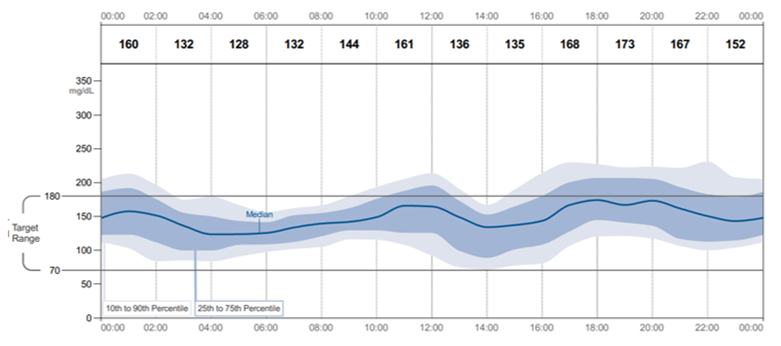
Figure 2: CGM data of case 1 prior to Alogliptin and after addition of Alogliptin (for 15 days) to the existing therapy
Figure 2A: CGM data (14 days) of case 1 prior to treatment with Alogliptin

Figure 3: Percentage (%) time in range and Percentage (%) time above range with CGM data in Case 1 prior to Alogliptin and after five weeks of addition of Alogliptin to the existing therapy
Figure 3A: Percentage (%) Time in range in case 1 prior to Alogliptin and after five weeks of addition of Alogliptin to the existing therapy
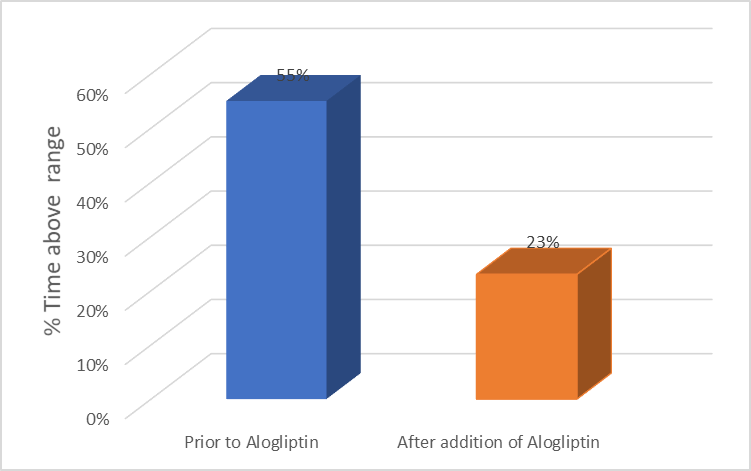
Figure 3B: Percentage (%) Time above range in case 1 prior to Alogliptin and after five weeks of addition of Alogliptin to the existing therapy
| Parameter | Prior to Alogliptin | After addition of Alogliptin (after five weeks) |
| Time in range | 67% | 91% |
| Time below range | 1% | 2% |
| Time above range | 32% | 7% |
Table 3: Time in range, Time below range and Time above range prior to Alogliptin and after five weeks of addition of Alogliptin to the existing therapy in Case 2
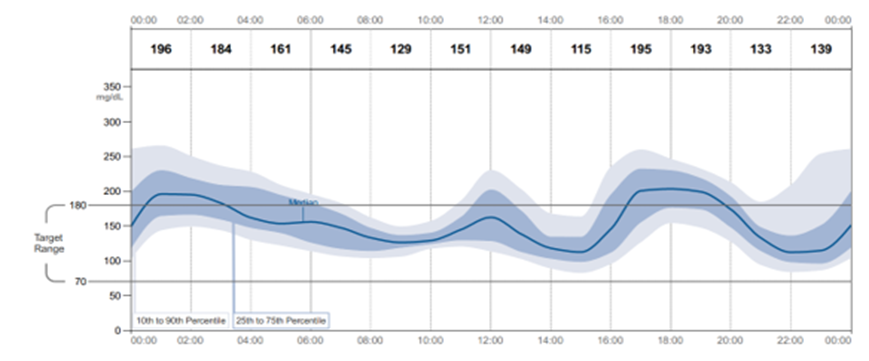
Figure 4: CGM data of case 1 prior to Alogliptin and after addition of Alogliptin to the existing therapy (for 15 days)
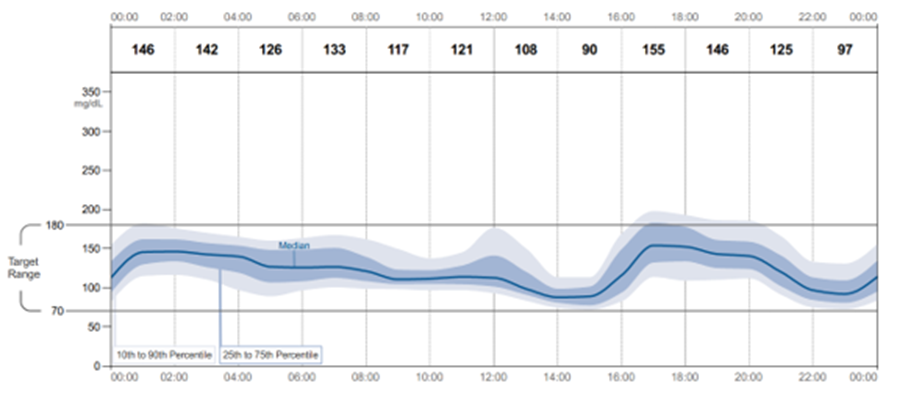
Figure 4A : CGM data of case 2 prior to treatment with Alogliptin (for 14 days)
Fig 4B: CGM data of case 2 after addition of Alogliptin (for 15 days) to the existing therapy

Figure 5 : Change in Percentage (%) time in range and Percentage (%) time above range with CGM data in Case 2 prior to Alogliptin and after five weeks of addition of Alogliptin to the existing therapy
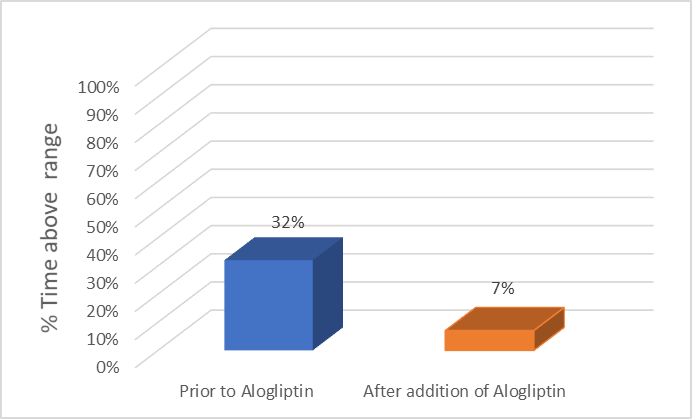
Figure 5A: Percentage (%) Time in range in case 2 prior to Alogliptin and after five weeks of addition of Alogliptin to existing therapy
Figure 5B: Percentage (%) Time above range in case 2 prior to Alogliptin and after five weeks of addition of Alogliptin to existing therapy

Figure 6: Change in HbA1c % prior to Alogliptin and after five weeks of addition of Alogliptin to existing therapy in Case 1 and 2

Figure 6A: Change in HbA1c % prior to Alogliptin and after five weeks of addition of Alogliptin to existing therapy in Case 1
Figure 6B: Change in HbA1c % prior to Alogliptin and after five weeks of addition of Alogliptin to existing therapy in Case 2
HbA1c realistically captures the average glycemic control in the retrospect, it is limited in assessing short-term outcomes and day-to-day glucose fluctuations. CGM devices provide a broad spectrum of additional glucose management metrics, including proportions of time in range (TIR), time below range (TBR), time above range (TAR), and glucose variability (GV).
The principal goal for all children and adults with type 1 diabetes and type 2 diabetes is to maintain:- At least 70% of TIR (70–180 mg/dL / 3.9–10 mmol/L), while at the same time minimizing both TBR and TAR: - less than 4% (1 h per d) of TBR (< 70> 180 mg/dL / 10 mmol/L). Targets should be individualized and in line with personal needs and circumstances. Each incremental 5% improvement in TIR is associated with clinically significant benefit.
Various studies have shown that frequent or large glucose fluctuations may lead to diabetes-related complications especially increased cardiovascular (CV) events due to the postprandial spikes in the blood glucose level as well as hypoglycemic events8. Strict HbA1c control alone is insufficient for preventing diabetes related complications, particularly the CV events caused by the long-term high GV. DPP4 inhibitors have the potential to improve glycemic control and to reduce glucose fluctuations, by increasing the active serum GLP-1 and GIP concentrations via glucose-dependent insulin secretion9. In a long term study of about 3.5 years in Japanese T2DM patients by Takebayashi K et al, it was found that Alogliptin once daily along with other OADs demonstrated a significant reduction in HbA1c (p = 0.0001)10. In another study by Kishimoto M et al it was observed that Alogliptin alone as well as in combination with Metformin reduced glycemic fluctuation in patients with T2DM11. In the present study, the administration of Alogliptin to existing anti-diabetic drugs decreased average blood glucose levels and reduced GV to a similar extent in patients with T2DM, as seen with improvement in percentage time in target range, percentage time above range and reduction in HbA1c after five weeks. There was no documented symptomatic hypoglycaemia during the study period of five weeks. This retrospective data demonstrated the efficacy of Alogliptin after addition to existing therapy in terms of improvement in glycemic variability.
In Indian T2DM patients inadequately controlled on other oral anti-diabetic drugs, co-administration of Alogliptin reduced glycemic fluctuations without any episodes of hypoglycemia. There were improvement in CGM parameters resulting in an increase in percentage (%) time in target range (70-180mg/dl) and decrease in percentage (%) time above target range due to addition of Alogliptin to existing OADs. Also the reduction in average blood glucose and HbA1c were seen in these patients after addition of Alogliptin to the existing antidiabetic regimen. This retrospective data demonstrated the efficacy of Alogliptin after addition to existing therapy in terms of improvement in glycemic variability.
Limitation of the study was it was a retrospective, observational data obtained from a small number of case based studies. Further studies with larger numbers of patients at multiple sites are necessary to provide a more complete understanding of the improvement in glycemic parameters in T2DM patients due to Alogliptin.
Clearly Auctoresonline and particularly Psychology and Mental Health Care Journal is dedicated to improving health care services for individuals and populations. The editorial boards' ability to efficiently recognize and share the global importance of health literacy with a variety of stakeholders. Auctoresonline publishing platform can be used to facilitate of optimal client-based services and should be added to health care professionals' repertoire of evidence-based health care resources.

Journal of Clinical Cardiology and Cardiovascular Intervention The submission and review process was adequate. However I think that the publication total value should have been enlightened in early fases. Thank you for all.

Journal of Women Health Care and Issues By the present mail, I want to say thank to you and tour colleagues for facilitating my published article. Specially thank you for the peer review process, support from the editorial office. I appreciate positively the quality of your journal.
Journal of Clinical Research and Reports I would be very delighted to submit my testimonial regarding the reviewer board and the editorial office. The reviewer board were accurate and helpful regarding any modifications for my manuscript. And the editorial office were very helpful and supportive in contacting and monitoring with any update and offering help. It was my pleasure to contribute with your promising Journal and I am looking forward for more collaboration.

We would like to thank the Journal of Thoracic Disease and Cardiothoracic Surgery because of the services they provided us for our articles. The peer-review process was done in a very excellent time manner, and the opinions of the reviewers helped us to improve our manuscript further. The editorial office had an outstanding correspondence with us and guided us in many ways. During a hard time of the pandemic that is affecting every one of us tremendously, the editorial office helped us make everything easier for publishing scientific work. Hope for a more scientific relationship with your Journal.

The peer-review process which consisted high quality queries on the paper. I did answer six reviewers’ questions and comments before the paper was accepted. The support from the editorial office is excellent.

Journal of Neuroscience and Neurological Surgery. I had the experience of publishing a research article recently. The whole process was simple from submission to publication. The reviewers made specific and valuable recommendations and corrections that improved the quality of my publication. I strongly recommend this Journal.

Dr. Katarzyna Byczkowska My testimonial covering: "The peer review process is quick and effective. The support from the editorial office is very professional and friendly. Quality of the Clinical Cardiology and Cardiovascular Interventions is scientific and publishes ground-breaking research on cardiology that is useful for other professionals in the field.

Thank you most sincerely, with regard to the support you have given in relation to the reviewing process and the processing of my article entitled "Large Cell Neuroendocrine Carcinoma of The Prostate Gland: A Review and Update" for publication in your esteemed Journal, Journal of Cancer Research and Cellular Therapeutics". The editorial team has been very supportive.

Testimony of Journal of Clinical Otorhinolaryngology: work with your Reviews has been a educational and constructive experience. The editorial office were very helpful and supportive. It was a pleasure to contribute to your Journal.

Dr. Bernard Terkimbi Utoo, I am happy to publish my scientific work in Journal of Women Health Care and Issues (JWHCI). The manuscript submission was seamless and peer review process was top notch. I was amazed that 4 reviewers worked on the manuscript which made it a highly technical, standard and excellent quality paper. I appreciate the format and consideration for the APC as well as the speed of publication. It is my pleasure to continue with this scientific relationship with the esteem JWHCI.

This is an acknowledgment for peer reviewers, editorial board of Journal of Clinical Research and Reports. They show a lot of consideration for us as publishers for our research article “Evaluation of the different factors associated with side effects of COVID-19 vaccination on medical students, Mutah university, Al-Karak, Jordan”, in a very professional and easy way. This journal is one of outstanding medical journal.
Dear Hao Jiang, to Journal of Nutrition and Food Processing We greatly appreciate the efficient, professional and rapid processing of our paper by your team. If there is anything else we should do, please do not hesitate to let us know. On behalf of my co-authors, we would like to express our great appreciation to editor and reviewers.

As an author who has recently published in the journal "Brain and Neurological Disorders". I am delighted to provide a testimonial on the peer review process, editorial office support, and the overall quality of the journal. The peer review process at Brain and Neurological Disorders is rigorous and meticulous, ensuring that only high-quality, evidence-based research is published. The reviewers are experts in their fields, and their comments and suggestions were constructive and helped improve the quality of my manuscript. The review process was timely and efficient, with clear communication from the editorial office at each stage. The support from the editorial office was exceptional throughout the entire process. The editorial staff was responsive, professional, and always willing to help. They provided valuable guidance on formatting, structure, and ethical considerations, making the submission process seamless. Moreover, they kept me informed about the status of my manuscript and provided timely updates, which made the process less stressful. The journal Brain and Neurological Disorders is of the highest quality, with a strong focus on publishing cutting-edge research in the field of neurology. The articles published in this journal are well-researched, rigorously peer-reviewed, and written by experts in the field. The journal maintains high standards, ensuring that readers are provided with the most up-to-date and reliable information on brain and neurological disorders. In conclusion, I had a wonderful experience publishing in Brain and Neurological Disorders. The peer review process was thorough, the editorial office provided exceptional support, and the journal's quality is second to none. I would highly recommend this journal to any researcher working in the field of neurology and brain disorders.

Dear Agrippa Hilda, Journal of Neuroscience and Neurological Surgery, Editorial Coordinator, I trust this message finds you well. I want to extend my appreciation for considering my article for publication in your esteemed journal. I am pleased to provide a testimonial regarding the peer review process and the support received from your editorial office. The peer review process for my paper was carried out in a highly professional and thorough manner. The feedback and comments provided by the authors were constructive and very useful in improving the quality of the manuscript. This rigorous assessment process undoubtedly contributes to the high standards maintained by your journal.

International Journal of Clinical Case Reports and Reviews. I strongly recommend to consider submitting your work to this high-quality journal. The support and availability of the Editorial staff is outstanding and the review process was both efficient and rigorous.

Thank you very much for publishing my Research Article titled “Comparing Treatment Outcome Of Allergic Rhinitis Patients After Using Fluticasone Nasal Spray And Nasal Douching" in the Journal of Clinical Otorhinolaryngology. As Medical Professionals we are immensely benefited from study of various informative Articles and Papers published in this high quality Journal. I look forward to enriching my knowledge by regular study of the Journal and contribute my future work in the field of ENT through the Journal for use by the medical fraternity. The support from the Editorial office was excellent and very prompt. I also welcome the comments received from the readers of my Research Article.

Dear Erica Kelsey, Editorial Coordinator of Cancer Research and Cellular Therapeutics Our team is very satisfied with the processing of our paper by your journal. That was fast, efficient, rigorous, but without unnecessary complications. We appreciated the very short time between the submission of the paper and its publication on line on your site.

I am very glad to say that the peer review process is very successful and fast and support from the Editorial Office. Therefore, I would like to continue our scientific relationship for a long time. And I especially thank you for your kindly attention towards my article. Have a good day!

"We recently published an article entitled “Influence of beta-Cyclodextrins upon the Degradation of Carbofuran Derivatives under Alkaline Conditions" in the Journal of “Pesticides and Biofertilizers” to show that the cyclodextrins protect the carbamates increasing their half-life time in the presence of basic conditions This will be very helpful to understand carbofuran behaviour in the analytical, agro-environmental and food areas. We greatly appreciated the interaction with the editor and the editorial team; we were particularly well accompanied during the course of the revision process, since all various steps towards publication were short and without delay".

I would like to express my gratitude towards you process of article review and submission. I found this to be very fair and expedient. Your follow up has been excellent. I have many publications in national and international journal and your process has been one of the best so far. Keep up the great work.

We are grateful for this opportunity to provide a glowing recommendation to the Journal of Psychiatry and Psychotherapy. We found that the editorial team were very supportive, helpful, kept us abreast of timelines and over all very professional in nature. The peer review process was rigorous, efficient and constructive that really enhanced our article submission. The experience with this journal remains one of our best ever and we look forward to providing future submissions in the near future.

I am very pleased to serve as EBM of the journal, I hope many years of my experience in stem cells can help the journal from one way or another. As we know, stem cells hold great potential for regenerative medicine, which are mostly used to promote the repair response of diseased, dysfunctional or injured tissue using stem cells or their derivatives. I think Stem Cell Research and Therapeutics International is a great platform to publish and share the understanding towards the biology and translational or clinical application of stem cells.

I would like to give my testimony in the support I have got by the peer review process and to support the editorial office where they were of asset to support young author like me to be encouraged to publish their work in your respected journal and globalize and share knowledge across the globe. I really give my great gratitude to your journal and the peer review including the editorial office.

I am delighted to publish our manuscript entitled "A Perspective on Cocaine Induced Stroke - Its Mechanisms and Management" in the Journal of Neuroscience and Neurological Surgery. The peer review process, support from the editorial office, and quality of the journal are excellent. The manuscripts published are of high quality and of excellent scientific value. I recommend this journal very much to colleagues.

Dr.Tania Muñoz, My experience as researcher and author of a review article in The Journal Clinical Cardiology and Interventions has been very enriching and stimulating. The editorial team is excellent, performs its work with absolute responsibility and delivery. They are proactive, dynamic and receptive to all proposals. Supporting at all times the vast universe of authors who choose them as an option for publication. The team of review specialists, members of the editorial board, are brilliant professionals, with remarkable performance in medical research and scientific methodology. Together they form a frontline team that consolidates the JCCI as a magnificent option for the publication and review of high-level medical articles and broad collective interest. I am honored to be able to share my review article and open to receive all your comments.

“The peer review process of JPMHC is quick and effective. Authors are benefited by good and professional reviewers with huge experience in the field of psychology and mental health. The support from the editorial office is very professional. People to contact to are friendly and happy to help and assist any query authors might have. Quality of the Journal is scientific and publishes ground-breaking research on mental health that is useful for other professionals in the field”.

Dear editorial department: On behalf of our team, I hereby certify the reliability and superiority of the International Journal of Clinical Case Reports and Reviews in the peer review process, editorial support, and journal quality. Firstly, the peer review process of the International Journal of Clinical Case Reports and Reviews is rigorous, fair, transparent, fast, and of high quality. The editorial department invites experts from relevant fields as anonymous reviewers to review all submitted manuscripts. These experts have rich academic backgrounds and experience, and can accurately evaluate the academic quality, originality, and suitability of manuscripts. The editorial department is committed to ensuring the rigor of the peer review process, while also making every effort to ensure a fast review cycle to meet the needs of authors and the academic community. Secondly, the editorial team of the International Journal of Clinical Case Reports and Reviews is composed of a group of senior scholars and professionals with rich experience and professional knowledge in related fields. The editorial department is committed to assisting authors in improving their manuscripts, ensuring their academic accuracy, clarity, and completeness. Editors actively collaborate with authors, providing useful suggestions and feedback to promote the improvement and development of the manuscript. We believe that the support of the editorial department is one of the key factors in ensuring the quality of the journal. Finally, the International Journal of Clinical Case Reports and Reviews is renowned for its high- quality articles and strict academic standards. The editorial department is committed to publishing innovative and academically valuable research results to promote the development and progress of related fields. The International Journal of Clinical Case Reports and Reviews is reasonably priced and ensures excellent service and quality ratio, allowing authors to obtain high-level academic publishing opportunities in an affordable manner. I hereby solemnly declare that the International Journal of Clinical Case Reports and Reviews has a high level of credibility and superiority in terms of peer review process, editorial support, reasonable fees, and journal quality. Sincerely, Rui Tao.

Clinical Cardiology and Cardiovascular Interventions I testity the covering of the peer review process, support from the editorial office, and quality of the journal.

Clinical Cardiology and Cardiovascular Interventions, we deeply appreciate the interest shown in our work and its publication. It has been a true pleasure to collaborate with you. The peer review process, as well as the support provided by the editorial office, have been exceptional, and the quality of the journal is very high, which was a determining factor in our decision to publish with you.
The peer reviewers process is quick and effective, the supports from editorial office is excellent, the quality of journal is high. I would like to collabroate with Internatioanl journal of Clinical Case Reports and Reviews journal clinically in the future time.

Clinical Cardiology and Cardiovascular Interventions, I would like to express my sincerest gratitude for the trust placed in our team for the publication in your journal. It has been a true pleasure to collaborate with you on this project. I am pleased to inform you that both the peer review process and the attention from the editorial coordination have been excellent. Your team has worked with dedication and professionalism to ensure that your publication meets the highest standards of quality. We are confident that this collaboration will result in mutual success, and we are eager to see the fruits of this shared effort.

Dear Dr. Jessica Magne, Editorial Coordinator 0f Clinical Cardiology and Cardiovascular Interventions, I hope this message finds you well. I want to express my utmost gratitude for your excellent work and for the dedication and speed in the publication process of my article titled "Navigating Innovation: Qualitative Insights on Using Technology for Health Education in Acute Coronary Syndrome Patients." I am very satisfied with the peer review process, the support from the editorial office, and the quality of the journal. I hope we can maintain our scientific relationship in the long term.
Dear Monica Gissare, - Editorial Coordinator of Nutrition and Food Processing. ¨My testimony with you is truly professional, with a positive response regarding the follow-up of the article and its review, you took into account my qualities and the importance of the topic¨.

Dear Dr. Jessica Magne, Editorial Coordinator 0f Clinical Cardiology and Cardiovascular Interventions, The review process for the article “The Handling of Anti-aggregants and Anticoagulants in the Oncologic Heart Patient Submitted to Surgery” was extremely rigorous and detailed. From the initial submission to the final acceptance, the editorial team at the “Journal of Clinical Cardiology and Cardiovascular Interventions” demonstrated a high level of professionalism and dedication. The reviewers provided constructive and detailed feedback, which was essential for improving the quality of our work. Communication was always clear and efficient, ensuring that all our questions were promptly addressed. The quality of the “Journal of Clinical Cardiology and Cardiovascular Interventions” is undeniable. It is a peer-reviewed, open-access publication dedicated exclusively to disseminating high-quality research in the field of clinical cardiology and cardiovascular interventions. The journal's impact factor is currently under evaluation, and it is indexed in reputable databases, which further reinforces its credibility and relevance in the scientific field. I highly recommend this journal to researchers looking for a reputable platform to publish their studies.

Dear Editorial Coordinator of the Journal of Nutrition and Food Processing! "I would like to thank the Journal of Nutrition and Food Processing for including and publishing my article. The peer review process was very quick, movement and precise. The Editorial Board has done an extremely conscientious job with much help, valuable comments and advices. I find the journal very valuable from a professional point of view, thank you very much for allowing me to be part of it and I would like to participate in the future!”
